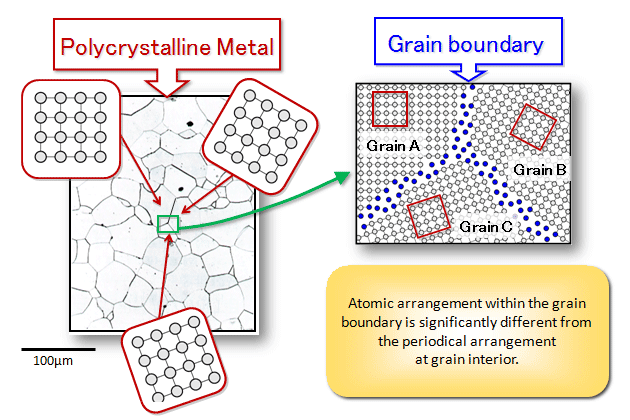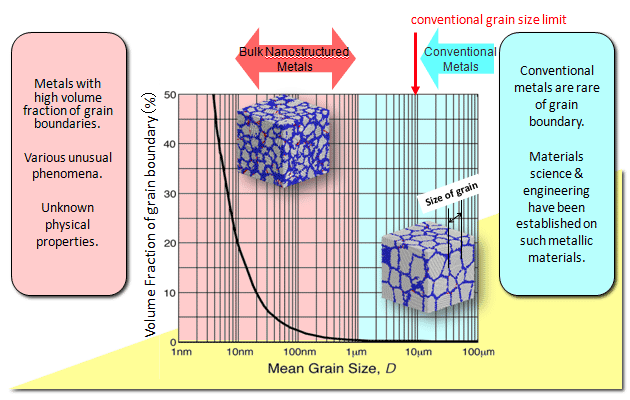HOMEOutline of Research - Background
Outline of Research
Background
It is known that about 80% of the elements in the periodic table are metallic elements, and each of them has own unique physical properties as well as characteristics. Present our highly developed society cannot keep without metallic materials. The most important characteristic of metallic materials is that they exhibit not only a high strength but also a no brittle manner (ductility / toughness). Due to these mechanical properties, they are usually applied for structural materials. With developing the technology, demands for structural metallic materials are becoming more and more severe. Concerning the environment / resources / energy problems that we are facing, the conventional materials design method that aims to improve the mechanical properties of the materials by only adding other elements is totally insufficient. Accordingly, a novel process, which is not just an extension of the conventional metallic material science but a discontinuous and drastic development of metallic materials science, is being desired. BNMs with simple alloy system can become the promising materials which give a drastic development in the field of metallic materials science.
Most of the metallic materials we are widely using in our society are polycrystals which consist of a large number of grains having different crystal orientation. It is empirically known that various properties of polycrystalline metals can be improved by grain refinement. Accordingly, the refinement of grains through conventional thermomechanical processes has been always an important issue in metallic materials. So far, however, the minimum grain size of bulky metallic materials we could achieve has been about 10µm. As shown in Fig. 1, the periodical three dimensional atomic configuration stopped at boundary between grains with different crystal orientation (grain boundary). Atoms on grain boundaries still keep bonding with those within the adjacent grains, because polycrystals have in bulky shape. Atomic configuration around grain boundary is different from the periodical one inside a grain. In addition, free volume of which size is smaller than atomic size should exist on the grain boundary.

Fig.1 Polycrystalline Metal and Grain Boundary
Assuming that the thickness of disordered area around grain boundary is 1 nm, the volume fraction of grain boundary in the polycrastal can be calculated as a function of mean grain size (Fig.2). From Fig.2, we find that the volume fraction of grain boundaries in the polycrystal with mean grain size larger than 10µm is expected to be almost 0%. This indicates that most of the metallic materials we have conventionally used are polycrystals with "rare of grain boundaries". In contrast, the volume fraction of grain boundaries greatly increases when the grain size becomes smaller than 1µm. We determined the bulky polycrystalline materials composed of matrix grains or phases having size smaller than 1µm as "Bulk Nanostructured Metals (BNMs)".

Fig.2 Bulk Nanostructured Metals are full of grain boundaries
The BNMs, which are considered as the materials "full of grain boundaries", expected to exhibit peculiar properties that have never seen in conventional metallic materials. Usually, slip movement of dislocations, which is one of the lattice defect, results in the deformation of metallic materials. High density of grain boundaries in BNMs changes the energy of each dislocation, leading to some unique behaviors, especially mechanical properties that are beyond our expectation. For example, BNMs exhibit strength four times higher than the same materials with conventional grain size. As a result, aluminum can be as strong as steel. Also, it is also possible to manage both high strength and large ductility or / and toughness in some kinds of BNMs, though strength and ductility / toughness are in trade-off relationship in conventional materials. Some phenomena which are observed only at high temperature in conventional materials, appear at low temperature regime in BNMs, because high density of grain boundaries enhances atomic diffusion regime. High density of grain boundaries and other lattice defects also increase the free energy of system, leading to peculiar solid-solid reactions, i.e., phase transformation, precipitation, and recrystallization. As the peculiar phenomena in BNMs are attributed to the high density of grain boundaries, they can appear even in pure metals or low alloy materials. Accordingly, BNMs can become the promising structural materials in future, with simple chemical compositions that lead to nice recyclability as well. It is also expected that the BNMs can give a discontinuous and drastic development in the field of metallic materials, and can give a big impact on our society.

